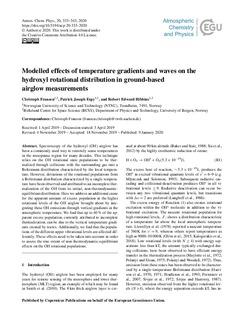| dc.contributor.author | Franzen, Christoph | |
| dc.contributor.author | Espy, Patrick Joseph | |
| dc.contributor.author | Hibbins, Robert | |
| dc.date.accessioned | 2020-03-04T07:41:29Z | |
| dc.date.available | 2020-03-04T07:41:29Z | |
| dc.date.created | 2020-01-13T14:30:56Z | |
| dc.date.issued | 2020 | |
| dc.identifier.citation | Atmospheric Chemistry and Physics. 2020, 20 333-343. | nb_NO |
| dc.identifier.issn | 1680-7316 | |
| dc.identifier.uri | http://hdl.handle.net/11250/2645056 | |
| dc.description.abstract | Spectroscopy of the hydroxyl (OH) airglow has been a commonly used way to remotely sense temperatures in the mesopause region for many decades. This technique relies on the OH rotational state populations to be thermalized through collisions with the surrounding gas into a Boltzmann distribution characterized by the local temperature. However, deviations of the rotational populations from a Boltzmann distribution characterized by a single temperature have been observed and attributed to an incomplete thermalization of the OH from its initial, non-thermodynamic equilibrium distribution. Here we address an additional cause for the apparent amount of excess population in the higher rotational levels of the OH airglow brought about by integrating these OH emissions through vertical gradients in the atmospheric temperature. We find that up to 40% of the apparent excess population, currently attributed to incomplete thermalization, can be due to the vertical temperature gradients created by waves. Additionally, we find that the populations of the different upper vibrational levels are affected differently. These effects need to be taken into account in order to assess the true extent of non-thermodynamic-equilibrium effects on the OH rotational populations. | nb_NO |
| dc.language.iso | eng | nb_NO |
| dc.publisher | European Geosciences Union | nb_NO |
| dc.rights | Navngivelse 4.0 Internasjonal | * |
| dc.rights.uri | http://creativecommons.org/licenses/by/4.0/deed.no | * |
| dc.title | Modelled effects of temperature gradients and waves on the hydroxyl rotational distribution in ground-based airglow measurements | nb_NO |
| dc.type | Journal article | nb_NO |
| dc.type | Peer reviewed | nb_NO |
| dc.description.version | publishedVersion | nb_NO |
| dc.source.pagenumber | 333-343 | nb_NO |
| dc.source.volume | 20 | nb_NO |
| dc.source.journal | Atmospheric Chemistry and Physics | nb_NO |
| dc.identifier.doi | 10.5194/acp-20-333-2020 | |
| dc.identifier.cristin | 1771582 | |
| dc.relation.project | Norges forskningsråd: 223252 | nb_NO |
| dc.description.localcode | © Author(s) 2020. This work is distributed under the Creative Commons Attribution 4.0 License. | nb_NO |
| cristin.unitcode | 194,66,20,0 | |
| cristin.unitname | Institutt for fysikk | |
| cristin.ispublished | true | |
| cristin.fulltext | original | |
| cristin.qualitycode | 2 | |

